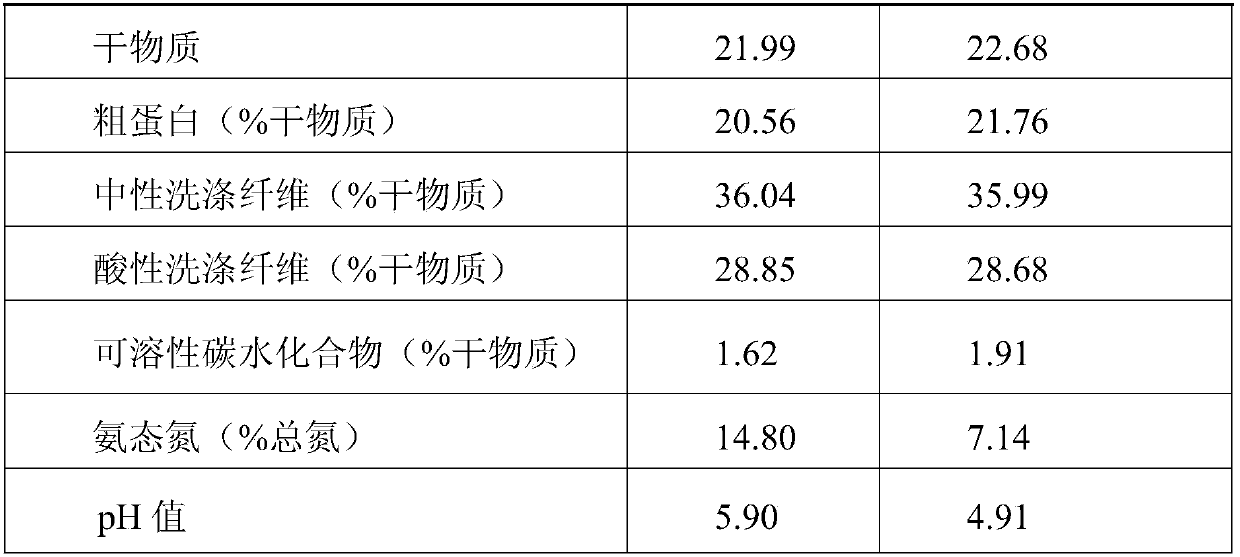Lactobacillus rhamnosus and application thereof in preparation of feed additives
A technology of Lactobacillus rhamnosus and bacterial agent, which is applied in the field of Lactobacillus rhamnosus and its application in the preparation of feed additives, can solve the problems of separation of alfalfa leaves and stems, pollution of silage raw materials, and reduction of nutritional components. Achieve the effect of improving the quality of alfalfa silage, solving the problem of silage and improving the quality of silage
- Summary
- Abstract
- Description
- Claims
- Application Information
AI Technical Summary
Problems solved by technology
Method used
Image
Examples
Embodiment 1
[0047] Example 1, Isolation, screening and identification of Lactobacillus rhamnosus
[0048] 1. Isolation and screening of strains
[0049] Collect alfalfa silage, take 20g of alfalfa silage and add 180ml of normal saline, soak for 2h, filter the leachate, shake it with an oscillator for 30min, 10 -1 -10 -6 For gradient dilution, take 1mL from each dilution gradient dilution and inoculate it into a petri dish, add 10-15ml sterilized MRS solid medium, shake well, wait for it to cool and solidify, and let it stand for anaerobic culture for 48h. Pick single colonies with obvious differences in colony shape, size, color and gloss, and repeat streaking until pure colonies are obtained. Single colonies were picked for Gram staining and catalase test. All Gram-positive, catalase-negative strains were initially identified as lactic acid bacteria, and then a lactic acid bacterium with high growth and acid production capacity was screened out with alfalfa fresh grass extract medium,...
Embodiment 2
[0060] Embodiment 2, Lactobacillus rhamnosus prepares alfalfa silage
[0061] 1. Preparation of alfalfa silage agent
[0062] 1. Inoculate Lactobacillus rhamnosus YLGG2017 into 15ml MRS liquid medium, and culture it statically at 37°C for 48h to obtain seed solution (OD 600nm = 1.864).
[0063] 2. Inoculate 0.5 μl of the seed liquid obtained in step 1 into 15 ml of MRS liquid medium (initial OD 600nm =0.02), cultured statically at 37°C for 24 hours to obtain a bacterial suspension (OD 600nm = 2.2).
[0064] 3. Centrifuge the bacterial suspension obtained in step 2 at 8000 rpm for 15 minutes to collect the bacterial cells, and wash the bacterial cells repeatedly with physiological saline.
[0065] 4. Freeze-dry after mixing the thalline precipitation after the processing of step 3 with 10ml sterilized skim milk to obtain the alfalfa silage bacterial agent (comprising 2.3 × 10 10 CFU / g of Lactobacillus rhamnosus YLGG2017).
[0066] 2. Preparation of alfalfa silage
[0067...
Embodiment 3
[0069] Embodiment 3, the detection of alfalfa silage
[0070] Get the alfalfa silage that embodiment 2 obtains and detect as follows:
[0071] 1. Take alfalfa silage samples, dry them in an oven at 65°C for 48 hours, and calculate the water content of alfalfa silage according to the weight loss.
[0072] 2. Take alfalfa silage samples, dry them in an oven at 65°C for 48 hours, and measure the content of water-soluble carbohydrates, crude protein, reducing sugars, free amino acids, neutral detergent fiber (NDF) and acid detergent fiber (NDF) content.
[0073] Water-soluble carbohydrates were determined by anthrone-sulfuric acid colorimetry.
[0074] Crude protein was determined by the Kjeldahl method (Full-automatic Kjeldahl analyzer from FOSS Company).
[0075] The reducing sugar was determined by 3,5-dinitrosalicylic acid colorimetric method.
[0076] Free amino acids were determined by the ninhydrin colorimetric method.
[0077] Neutral detergent fiber (NDF) content and...
PUM
 Login to View More
Login to View More Abstract
Description
Claims
Application Information
 Login to View More
Login to View More - R&D
- Intellectual Property
- Life Sciences
- Materials
- Tech Scout
- Unparalleled Data Quality
- Higher Quality Content
- 60% Fewer Hallucinations
Browse by: Latest US Patents, China's latest patents, Technical Efficacy Thesaurus, Application Domain, Technology Topic, Popular Technical Reports.
© 2025 PatSnap. All rights reserved.Legal|Privacy policy|Modern Slavery Act Transparency Statement|Sitemap|About US| Contact US: help@patsnap.com


